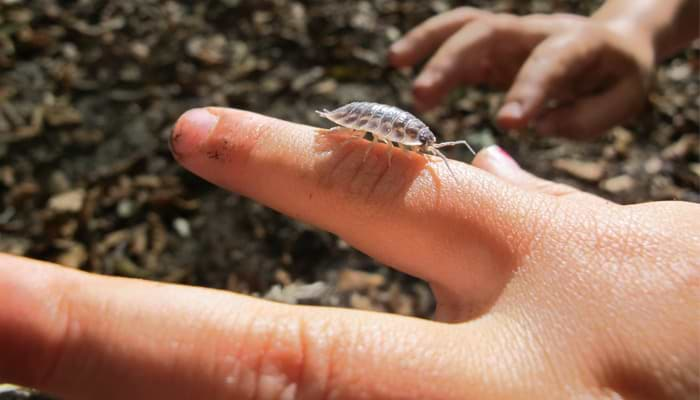
© Elvira Werkman / Shutterstock.com
The humble woodlouse is a little garden creature that usually doesn't warrant a second glance. However, this fascinating crustacean is one of the planet's oldest living species - with fossils suggesting its ancestors date back an amazing 160 million years. The woodlouse is interesting for many other reasons - did you know it has SEVEN pairs of lungs and more than 170 nicknames? Even more bizarre is the fact woodlice racing has been practised in rural communities, and they are even kept as children's pets! What is a woodlouse? A woodlouse is a crustacean from the Oniscidea suborder of isopods that comprises around 10,000 different species worldwide. They can live on land, in the sea, or in freshwater. The isopods' common features are their segmented, rigid exoskeletons, seven pairs of jointed limbs and two pairs of antennae. Today's woodlice come from the order Isopoda that is related to crabs and lobsters. Trilobite fossils from their ancestors date from the Eocene period, 50 million years ago. Scientists believe the presence of thousands of species worldwide suggests they existed 110 million years earlier before the continents drifted apart. Woodlice breathe through trachea-like lungs in their hind legs. Some species have two lungs, while others have up to seven pairs! Although they live in non-aquatic environments, they need plenty of water, as they lose moisture quickly through their cuticles. For this reason, they tend to live in damp, dark places, such as under logs and rocks. Female woodlice carry fertilised eggs in a pouch, marsupial-style, providing the developing embryos with nutrients, oxygen and water as they grow. Once the young (mancae) hatch, they receive further maternal care in some species of woodlice. The juveniles then go through a series of "moults" before they reach maturity. How many woodlice are there in Britain? There are around 3,500 species of woodlice worldwide, with some 50 types found in Britain today. Of these, 37 are native or naturalised species. The remainder have arrived in the UK with imported plants and have multiplied. Their rapid breeding rate was noted at the Eden Project in Cornwall, where 14 species of woodlice had established themselves in its rainforest biome in just seven years after it opened in 2003. A further four species were found in the Mediterranean biome and an additional seven in outdoor areas. Of the 25 species there, 11 were either new, or little research had been carried out on them. They breed so rapidly because the female lays eggs three times a year. She lays around 50 eggs each time and can live for two to four years, depending on the species. The most common woodlouse in Britain is the familiar 14-segment variety, with seven pairs of legs. They number untold millions and can be found in every garden, tree stump and log pile in the country, feeding off decaying wood - hence their name. Why do woodlice have so many nicknames? Research has found the woodlouse has 176 known nicknames including chisel-hog, bibble-bug, palmerworm, roly-poly, monkey-pea, chuggy-pig, slater, Johnny-grump and many more. The names have been carried down over the centuries. Most are ancient names, as the woodlouse attracts little attention today. Some can be explained, but others seem to have no meaning whatsoever. The name cudworm originated in Shropshire and referred to woodlice being used to supplement cattle feed. The nickname cheesy bob related to the odour emitting from a large number of woodlice. It has also been called carpenter and coffin-cutter, reflecting its habitat and diet, while the nickname armadillo-bug relates to its resemblance to the armoured mammal. The largest number of nicknames relate to pigs, according to a 1988 study by Dr Frederick Laver and the Devon Women's Institute. They found the nicknames chucky-pigs, grammer-pigs and pigs-lice were common across seven of the UK's 27 counties. The reason is said to be because the back of a woodlouse resembles a row of feeding piglets huddled in a pen. In Cornwall, they are known colloquially as grammasows and sowpigs. The latter is also their nickname in Devon, where other monikers include chiggypigs or choogeypigs. In Dorset, they are chiggywigs. Why shouldn’t you kill woodlice? Some people just don't like creepy-crawlies, but there are lots of benefits of having woodlice in your garden and you should never kill them. Woodlice are omnivores, as their specialised digestive system enables them to have a wide and varied diet. They can eat things that would poison other species such as mould, animal feces, decomposing food and cellulose. They don't harm humans and play an important role in the cycle of decomposition and regrowth in nature. Birds, spiders and frogs eat woodlice and they provide a good source of calcium. They usually live among garden leaf litter, feeding mostly on damp, decomposing plants, so they are useful recyclers in your garden, according to the Royal Horticultural Society. They don't normally eat or damage healthy plants - damage to plants is often caused by slugs and caterpillars and woodlice are rarely to blame. More prevalent in the spring and summer months, when the weather gets colder, you will be more likely to find them in your garden shed or greenhouse. In autumn, it's a good idea to fill cracks around skirting boards or windows with decorator’s caulk to stop woodlice from getting into your home, as they search for somewhere warmer. Benefits of wildlife in your garden Everything in the garden, from the humble woodlouse to bees, butterflies and the myriad of insects, has a role to play in preserving nature's delicate balance and helping the planet to survive. Next time you're doing a spot of gardening, or toiling at your allotment, if you find woodlice, remember how important they are and celebrate the fact they have chosen your plot to set up home!




